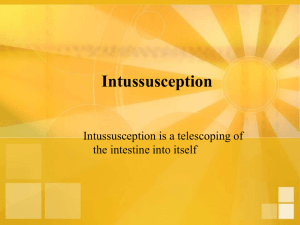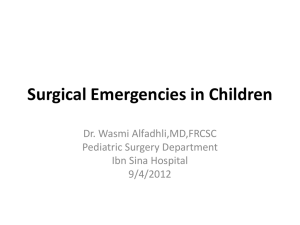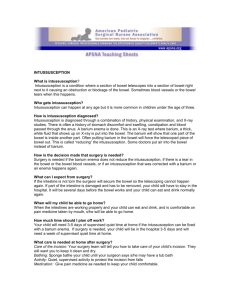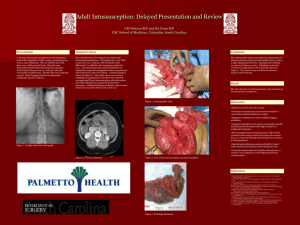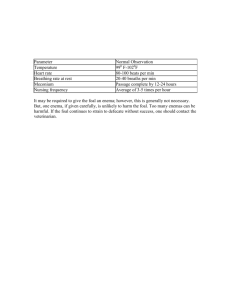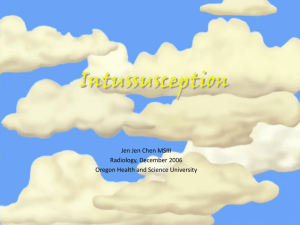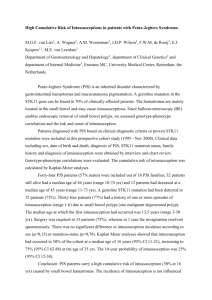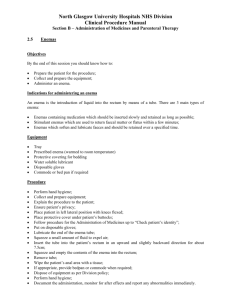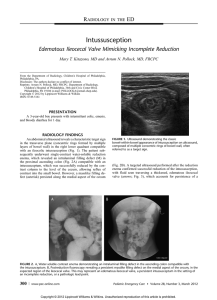1 Kimberly E. Applegate, MD, MS Indiana University Department of Radiology
advertisement
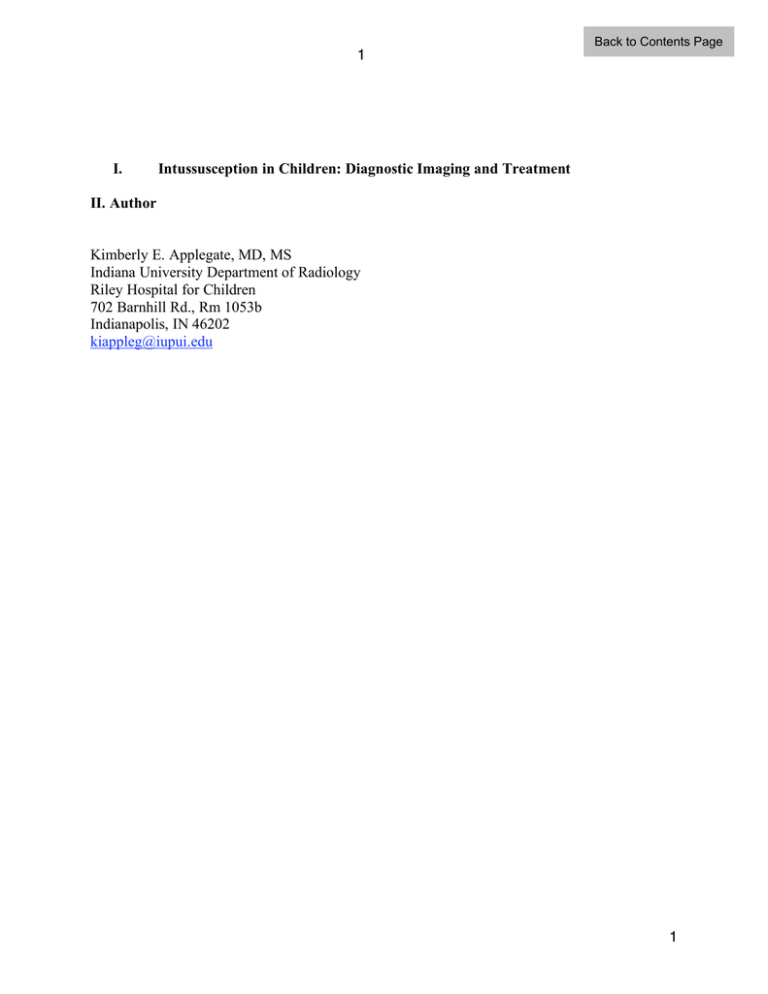
1 I. Back to Contents Page Intussusception in Children: Diagnostic Imaging and Treatment II. Author Kimberly E. Applegate, MD, MS Indiana University Department of Radiology Riley Hospital for Children 702 Barnhill Rd., Rm 1053b Indianapolis, IN 46202 kiappleg@iupui.edu 1 2 III. KEY POINTS VI. ISSUES: 1. Intussusception: Issue 1. Who should undergo imaging? Issue 2. What imaging should be performed? Issue 3. How should therapeutic enema be performed? Issue 4. What is appropriate management in recurrent cases? Special case: Intussusception limited to small bowel Special case: Intussusception with a lead point mass . IV. KEY POINTS: -Children with clinically suspected intussusception should undergo enema reduction after surgical consultation. The only absolute contraindications to enema are signs of peritonitis on clinical exam or free air on abdominal radiographs. Air enema has better overall reduction rates than liquid enema but the outcome depends on the experience of the radiologist. (MODERATE EVIDENCE) 2 3 -Barium should not be used due to the poorer outcomes in those children who perforate. (MODERATE EVIDENCE) - Ultrasound (US) is the primary imaging modality for initial diagnosis outside of the USA and a growing majority of pediatric radiologists in the USA. US also plays a role in the evaluation of reducibility of intussusception, presence of a lead point mass, potential incomplete reduction after enema, and of intussusception limited to small bowel. (LIMITED EVIDENCE) -Abdominal radiographs have poor sensitivity for the detection of intussusception but may serve to screen for other diagnoses in the differential diagnosis, such as constipation, and for free peritoneal air. For screening children with a low probability for intussusception, sonography is the preferred screening test. (LIMITED EVIDENCE) -The use of delayed repeat enema for the reduction of intussusception shows promise but there are few data on the appropriate methods or time. (LIMITED EVIDENCE) - For recurrence of intussusception, including multiple recurrences, enema is the preferred method for reduction. (LIMITED EVIDENCE) 3 4 X. Discussion of Issues Issue 1: Diagnosis of Intussusception:What are the clinical predictors? Who should undergo imaging? Summary At this point there are no reliable clinical prediction models that can accurately identify all patients with intussusception (LIMITED EVIDENCE).Determination of which children should undergo imaging, and which should not undergo imaging, has not been studied in formal prospective trials. Issue 2: What imaging should be performed? Summary Ultrasound has higher accuracy in the diagnosis of intussusception than plain radiographs. Ultrasound also has higher diagnostic accuracy in identifying pathologic lead points than plain radiographs or enema. The role of ultrasound findings in predicting success of reduction is not well known with available literature. Given current evidence, the diagnostic approach should include: (a) abdominal radiographs if concern for other diagnoses or for perforation (b) sonography for diagnosis or exclusion of intussusception, (c) if positive, a surgical consult should be obtained prior to the enema reduction attempt, and (d) air enema reduction (or if no experience with the air technique, liquid enema) (MODERATE EVIDENCE). 4 5 Issue 3: Treatment of intussusception: How should the enema be performed? Summary The air enema is considered superior at reduction, cleaner (based on appearance of peritoneal cavity at surgery when perforation occurs), safer, and faster, with less radiation when compared to liquid enema (MODERATE EVIDENCE). The recurrence rates for air versus liquid enema reductions do not differ (both are approximately 10%). The ‘Rule of Threes’ used to guide liquid enema technique is supported by limited evidence. Barium is no longer the liquid contrast medium of choice due to the risk of barium peritonitis, infection, and adhesions when perforation occurs during the enema. Neither sedation nor medications increase the enema success rate (Limited Evidence). Direct comparison of reduction with fluoroscopy versus ultrasound has not been studied (Insufficient Evidence). Issue 4: What is the appropriate management in recurrent cases? Summary Intussusception recurrence rates average 10% in large series, with a range of 5.4% to 15.4%, regardless of air versus liquid enema technique (MODERATE EVIDENCE). The recurrence rates are less than or equal to 5% when surgical reduction is performed, presumably due to the 5 6 development of adhesions. Repeat enema is both safe and effective in recurrent intussusception as long as the child remains clinically stable (LIMITED EVIDENCE). There is insufficient evidence to support any particular approach beyond the performance of the enema and referral to a surgeon for shared decision-making with the patient. Special case: Intussusception limited to the small bowel With the increasing use of multi-detector CT scanners, radiologists are reporting more frequent presence of small, asymptomatic small bowel-small bowel intussusception (LIMITED EVIDENCE). These intussusceptions are typically transient and, since the children are asymptomatic, they are of no known clinical significance. There is little evidence in the literature regarding the optimal diagnosis and treatment of symptomatic intussusception limited to the small bowel. Most authors agree however, that the diagnosis is more difficult both clinically and radiologically . Small bowel intussusceptions are unlikely to have associated abdominal mass or rectal bleeding. Treatment is virtually always surgical reduction. Special risk factors for small bowel intussusception include the early postoperative period after either intraperitoneal and retroperitoneal surgery, the presence of long enteric feeding tubes, diffuse PLP (cystic fibrosis or HSP), and small bowel polyps (LIMITED EVIDENCE). Special case: Intussusception with a known lead point mass 6 7 The optimal imaging approach to children with intussuception and known PLP is unknown. However, Daneman surveyed the SPR members at their 2004 annual meeting and found that 76% of respondents attempt reduction in these patients. Some surgeons may request enema reduction in these children to partially reduce the intussusception and perhaps decrease the laparotomy incision size. There is insufficient evidence to support any particular approach beyond referral to a surgeon for shared decision-making with the patient and if requested, the performance of an enema. Back to Contents Page 7
